英语教学设计 Unit6Whenwasitinvented教学设计
- 格式:docx
- 大小:17.88 KB
- 文档页数:7
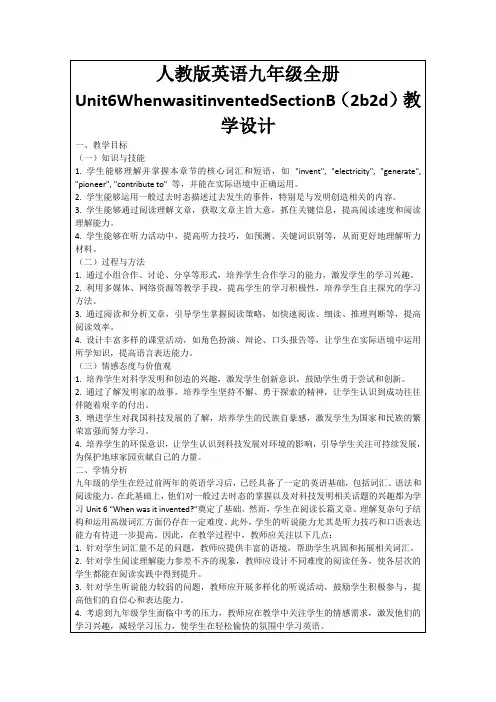

Unit 6 When was it invented?(第4课时)教学设计一. 教材分析Unit 6 “When was it invented?” 是人教版PEP小学英语六年级上册的一单元,主题是询问发明物的发明时间。
本节课主要教授一般过去时的疑问句和回答,以及与发明物相关的词汇。
教材通过介绍各种发明物的发明时间,激发学生对科学的兴趣和好奇心。
二. 学情分析六年级的学生已经掌握了基本的英语语法和词汇,具备一定的听、说、读、写能力。
他们对新鲜事物充满好奇,善于模仿和探究。
在信息技术方面,学生已经掌握了基本的网络搜索能力和多媒体应用能力,可以利用网络资源进行自主学习。
三. 教学目标1.知识目标:学生能够听懂、会说、会读本节课的主要词汇和句型,了解一般过去时的疑问句和回答。
2.能力目标:学生能够在真实情境中运用所学知识进行交流,提高口语表达能力。
3.情感目标:学生对科学发明产生兴趣,培养创新精神和团队合作意识。
四. 教学重难点1.重点:学生能够正确运用一般过去时的疑问句和回答,以及本节课的主要词汇。
2.难点:学生能够在实际情境中灵活运用一般过去时,询问和描述发明物的时间。
五. 教学方法1.情境教学法:通过设定各种情境,让学生在实际环境中运用英语进行交流。
2.任务型教学法:学生分组完成各种任务,培养团队合作精神和创新能力。
3.信息技术辅助教学:利用多媒体课件、网络资源等手段,提高教学效果。
六. 教学准备1.教学课件:制作课件,包括本节课的主要词汇、句型和发明物介绍。
2.网络资源:收集与发明物相关的图片、视频等资料。
3.练习题:准备相关的练习题,用于巩固所学知识。
七. 教学过程1.导入(5分钟)利用网络资源展示各种发明物的图片,引导学生谈论这些发明物。
例如:“Do you like these inventions? Why?” 让学生自由回答,激发他们对本节课的兴趣。
2.呈现(10分钟)教师展示本节课的主要词汇和句型,如:“What was it invented?” “It was invented in…” 让学生跟读并模仿。

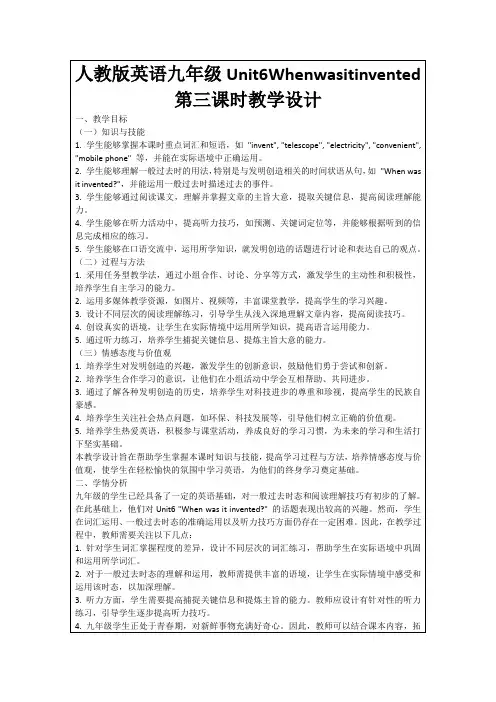


Unit 6 When was it invented?SectionA 2a2dName Class SN Date Total points 17 【Examination Point】be used for 的用法。
【Study aims】1.掌握本课时单词:heel, scoop, electricity, style, project, pleasure, zipper, daily, have a point, website, pioneer, list, mention;2.能够运用一般过去时的被动语态,谈论物品的发明者和用途;Who was it invited by?It was invited by...What are they used for?They are used for ...3.通过学习,能够懂得科学发明改变人类生活。
【Key&difficult points】能够运用一般过去时的被动语态,谈论物品的发明者和用途。
【Lead in】Show pictures of some inventions, then ask a question: When they were invented? Who was it invented by? (2mins)【Step one】Prelistening:(7mins)Look at the pictures in 2a, and then think about the following questions:1.What can you see in the picture?2.What is the boy doing?3.What is the girl dong?4.What is the scoop used for?【Step two】Whilelistening:(5mins)plete 2a, Listen and number the inventions [13] in the order you hear them.plete 2b: These are interesting inventions.Who are they invented by? What are they used for? Please listen carefully and fill in the chart.【Group work】Postlistening:(5mins)Make conversations using the information in 2b, make a sample conversation like this:【Step three】Roleplay the conversations in 2d.(5mins)【当堂训练】时间:8分钟(要求:书写认真,规范)【课堂小结】1.询问物品的发明者:?回答:.2.询问物品的用途:?回答:.Signature:。
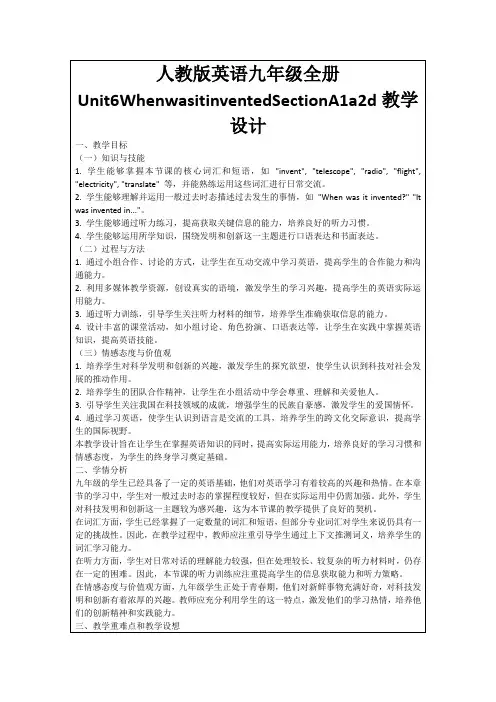
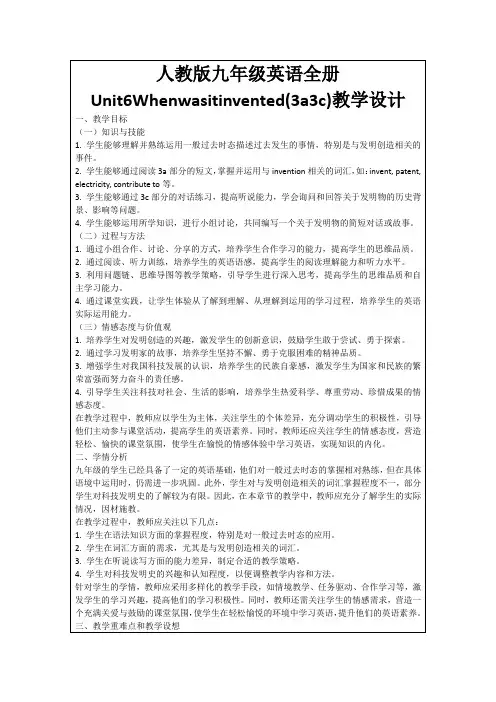

Unit 6 When was it invented?(第1课时)教学设计一. 教材分析Unit 6 “When was it invented?” 是人教版小学英语PEP教材三年级下册的一单元。
本单元主要学习一般过去时,让学生能够运用一般过去时询问和回答关于物品发明的时间。
本节课的主要内容是词汇和句型的学习,包括动词短语“draw pictures”, “tell stories”, “play chess”, “have a snack” 等,以及一般过去时的疑问句和回答。
同时,本节课还涉及到一些时间表达法,如“yesterday”, “last week” 等。
二. 学情分析学生在之前的学习中已经掌握了一般现在时,对动词短语和时间表达法有一定的了解。
但三年级的学生对一般过去时的理解和运用还有待提高。
因此,在教学过程中,需要通过具体的情境和活动帮助学生理解和运用一般过去时。
三. 教学目标1.知识目标:学生能够听懂、会说、会读本节课的主要词汇和句型,如动词短语“draw pictures”, “tell stories”, “play chess”, “have a snack” 等,以及一般过去时的疑问句和回答。
2.能力目标:学生能够在适当的情境中运用一般过去时进行交流,提高语言运用能力。
3.情感目标:培养学生对英语学习的兴趣,激发学生探索科技发展历史的欲望。
四. 教学重难点1.重点:学生能够掌握本节课的主要词汇和句型,能够用一般过去时进行简单的交流。
2.难点:学生能够正确运用一般过去时,特别是在实际情境中进行运用。
五. 教学方法1.情境教学法:通过设置科技发明的历史情境,让学生在具体的情境中学习和运用语言。
2.任务型教学法:通过小组合作完成任务,激发学生的学习兴趣,提高学生的语言运用能力。
3.游戏教学法:通过趣味性的游戏活动,巩固所学知识,提高学生的学习积极性。
六. 教学准备1.教学课件:制作多媒体课件,包括图片、动画、视频等,帮助学生直观地理解和学习。
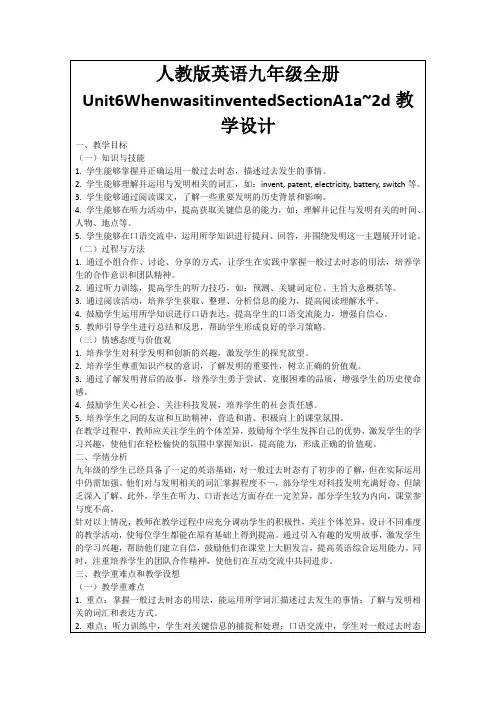
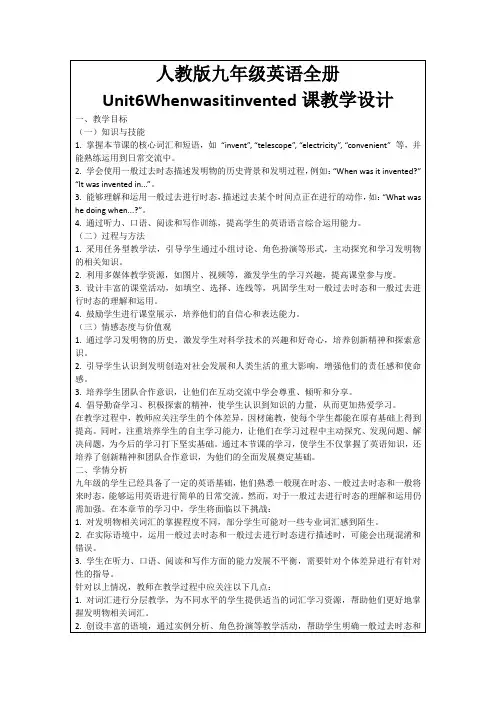
《九年级英语Unit6When was it invented?教学设计》
一、教学目标
1.掌握被动语态的一般过去时。
2.了解一些重要发明的历史和影响。
3.培养学生的创新意识和科学精神。
二、教学重难点
1.重点:被动语态的一般过去时和发明相关词汇。
2.难点:正确运用被动语态描述发明的历史。
三、教学方法
历史故事法、语法讲解法、小组合作法。
四、教学过程
1.导入
播放一段关于重要发明的视频,引出话题。
2.词汇学习
教授与发明相关的词汇,如:invent,invention,inventor等。
3.语法讲解
讲解被动语态的一般过去时的结构和用法,通过例句和练习巩固。
4.历史故事分享
学生分享自己知道的一个重要发明的历史故事,运用被动语态进行描述。
5.阅读教学
阅读一篇关于发明对人类生活影响的文章,回答问题并分析文章。
6.小组讨论
学生分组讨论未来可能的发明及其影响。
7.总结归纳
总结被动语态的一般过去时和发明的相关表达。
8.作业布置
(1)复习本单元词汇和语法。
(2)写一篇关于自己想象中的发明的短文,描述其功能和影响。
人教版九年级英语《Unit 6 When was it invented?》教学设计一. 教材分析人教版九年级英语《Unit 6 When was it invented?》主要介绍了与日常生活相关的科学技术发明的历史。
本单元包括一般过去时的被动语态,以及表示过去某段时间经常发生的动作或存在的状态的用法。
本节课旨在让学生掌握一般过去时的被动语态,能够运用本课所学内容进行交流。
二. 学情分析九年级的学生已经具备了一定的英语基础,能够听、说、读、写简单的英语句子。
但部分学生在语言表达方面仍有困难,需要教师的耐心引导和鼓励。
此外,学生对于科技发明的历史知识了解有限,需要在教学过程中进行补充。
三. 教学目标1.知识目标:–掌握一般过去时的被动语态。
–了解与日常生活相关的科学技术发明的历史。
2.能力目标:–能够运用一般过去时的被动语态进行交流。
–提高学生的听说读写能力。
3.情感目标:–激发学生对科学技术发展的兴趣。
–培养学生的创新意识。
四. 教学重难点•一般过去时的被动语态。
•与日常生活相关的科学技术发明的历史。
•一般过去时的被动语态的运用。
•对科学技术发明历史的理解。
五. 教学方法1.情境教学法:通过设定情境,让学生在实际语境中学习、运用英语。
2.交际法:引导学生进行互动交流,提高口语表达能力。
3.任务型教学法:通过完成任务,培养学生综合运用英语的能力。
4.启发式教学法:引导学生主动思考,激发学习兴趣。
六. 教学准备1.教材:人教版九年级英语《Unit 6 When was it invented?》。
2.辅助材料:科技发明历史的相关图片、视频等。
3.多媒体设备:投影仪、电脑等。
4.教学卡片:一般过去时的被动语态的句子。
七. 教学过程1.导入(5分钟)利用图片或视频介绍科学技术发明的历史,激发学生的兴趣。
引导学生谈论自己了解的科技发明,复习一般过去时。
2.呈现(10分钟)展示本节课的主要内容,引导学生关注一般过去时的被动语态。
人教版九年级英语《Unit 6 When was it invented?》Section A教学设计1一. 教材分析人教版九年级英语《Unit 6 When was it invented?》Section A主要介绍了与日常生活相关的几个重要发明的年代。
本节课主要围绕过去时态进行描述,通过学习本节课,学生能够掌握一般过去时的构成和用法,以及如何用一般过去时描述过去发生的事情。
教材内容贴近生活,有利于激发学生的学习兴趣和积极性。
二. 学情分析九年级的学生已经掌握了基本的英语语法知识和一定程度的词汇量,具备一定的听说读写能力。
但部分学生对过去时态的掌握还不够扎实,需要在本节课中进一步巩固。
此外,学生对日常生活中的科技产品有一定的了解,但可能对一些历史悠久的发明不太熟悉,需要在课堂上进行引导和拓展。
三. 教学目标1.知识目标:–学会一般过去时的构成和用法。
–掌握本节课的重点词汇和短语。
–能够用一般过去时描述过去发生的事情。
2.能力目标:–提高学生的听说读写能力,尤其是听力和口语表达能力。
–培养学生的合作意识和团队精神。
3.情感目标:–激发学生对科技发展的兴趣,培养学生的创新意识。
–增强学生对国家科技历史的自豪感。
四. 教学重难点•一般过去时的构成和用法。
•本节课的重点词汇和短语。
•一般过去时在实际语境中的运用。
•对部分科技发明的了解和描述。
五. 教学方法1.任务型教学法:通过设定各种任务,激发学生的学习兴趣,培养学生的实践能力。
2.情境教学法:创设真实情境,让学生在实践中学习、巩固知识。
3.合作学习法:引导学生分组讨论、合作完成任务,提高学生的团队协作能力。
六. 教学准备1.教师准备:–制作课件和教学素材。
–准备相关科技发明的历史资料。
2.学生准备:–预习教材,了解本节课的基本内容。
–搜集一些科技发明的历史资料,以便课堂上分享。
七. 教学过程1.导入(5分钟)–教师通过提问方式引导学生复习一般现在时,为新课的学习做好铺垫。
Un i t6 When was i t i nvented?教学设计Sect i on A (grammarfocus-4c)一、教学目标:1.语言知识目标:I)学习掌握下列词汇:fridge, low, somebody, translate, lock, earthquake, sudden, all of a sudden, biscuit, cookie, instrument2)进行一步复习巩固学习Section A部分所学的生词和词组。
3)进一步学习运用一般过去时态的被动语态。
4)掌握主动语态变被动语态的方法,并通过不同方式的练习,来熟练运用。
2.情感态度价值观目标:培养想象力,善于观察事物。
面对难题,用积极的态度去解决,发挥想象力,认识世界,改造世界。
二、教学重难点1.教学重点:1)学习生词fridge, low, somebody, translate, lock, earthquake, sudden, all of a sudden, biscuit, cookie, instrument2)复习巩固Section A部分所学的生词和词组,达到熟练运用的目标。
2.教学难点:1)一般过去时态的句子变为被动语态。
2)综合运用所学的知识进行练习运用。
三、教学过程I . Warming- up and revision1.Have a dictation of the new words learned in the last class.2.Review some main phrases \vc learned in the last class. Check the homework.3.Let some Ss tell something about how tea was invented by accident.Tell something about how tea was invented by accident.One day Shen Nong was boiling drinking water over an open fire. Some leaves from a tea plant fell into the water and remained there for some time.It produced a nice smell so he tasted the brown water. It was quite delicious and one of the world's favorite drink was invented.Tell something about Lu Yu and his Cha Jing.Lu Yu “the saint of tea” mentioned Shen Nong in his book Cha Jing. The book describes how tea plants were grown and used to make tea. It also discusses where the finest tea leaves were produced and what kinds of water were used.It is believed that tea was brought to Korea and Japan during 6th and 7th centuries. In England, tea didn't appear until around 1660. The tea trade from China to Western countries took place in the 19th century.II. Grammar Focus.I.学生阅读Grammar Focus中的句子,然后做填空练习。
① 拉链是什么时候被发明的?the zipper?②它于1893年被发明。
It in 1893.③它是由谁发明的?it invented?④它是由惠特科姆•贾得森发明的。
It Whitcomb Judson.⑤茶叶什么时候被带到朝鲜去的?tea to Korea?⑥茶叶在六到七世纪之间被带到朝鲜。
It to Korea the 6th and 7th centuries.⑦热冰淇淋勺用来做什么?What the hot ice-cream?⑧它用于挖很冷的冰淇淋。
It's really cold ice-cream.⑨ 电话机在1876年被贝尔所发明。
The telephone Alexander Graham Bell in 1876.⑩贝尔于1876年发明了电话机。
Alexander Graham Bell the telephone in 1876.2.学生们根据记忆,看大屏幕来完成填空练习。
3.学生们完成填空试题后,可以打开课本检查答案,对错误的句子,单独进行强化记忆。
III. Grammar一般过去时态的被动语态的构成英语有两种语态:主动语态和被动语态。
主动语态表示主语是动作的执行者, 而被动语态则表示主语是动作的承受者。
如:We cleaned the classroom yesterday.我们昨天打扫了教室。
(主动语态,主语we是clean这一动作的执行者)The classroom was cleaned yesterday.教室昨天被打扫。
(被动语态,主语the classroom是clean这一动作的承受者)一、一般过去时被动语态一般过去时被动语态的结构为“主语+ was /were +及物动词的过去分词(+by+动作的执行者)如:Trees were planted last spring.去年春天种了树。
1.肯定句:主语+ was/were+及物动词的过去分词+其他.Paper was invented by Chinese people two thousand years ago.纸是中国人在二千多年前发明的。
2.否定句:主语+ was/were not +及物动词的过去分词+其他.Women were not allowed to take part in the games at first.开始妇女不允许参加奥运会。
3. 一般疑问句:Was/Were+主语+及物动词的过去分词+其他?Were these pictures drawn by your sister?这些图片是由你妹妹画的吗?二、被动语态的用法:1.不知道谁是动作的执行者,或没有必要指出谁是动作的执行者。
e.g. English is spoken all over the world. 全世界都在说英语。
2.需要突出或强调动作的承受者。
e.g. This dictionary is used by most students.这本字典是大多数学生在用的。
三、主动语态变被动语态应注意的问题1.有些短语动词相当于及物动词,变为被动句时介词或副词不能去掉。
They put off the meeting because of the weather.The meeting was put off because of the weather.会议因天气的缘故被推迟了。
2.含有双宾语的主动句变为被动句时,通常把指“人''的间接宾语变为主语, 指“物”的直接宾语保留不变;如果把指物''的直接宾语变为主语,则在间接宾语前加to或for。
My aunt gave me an e-dictionary yesterday.I was given an e-dictionary yesterday.An e-dictionary was given to me yesterday.3.主动句中感官动词see/hear/watch/feel等和使役动词make/let/have等后跟省略to的动词不定式,变为被动语态时应加上不定式符号tOoI saw a heavy man enter the house.A heavy man was seen to enter the house.4.系动词、不及物动词或某些短语动词(happen, take place, come true, fall asleep...)没有被动语态。
What happened to Mr. Brown?布朗先生发生了什么事?IV.Exercises练一练将下列句子变为被动语态。
1.He chose six story books the other day.Six story books by him the other day.2.Uncle Lee gave Jack a large cake for he painted the wall wonderfully.Jack a large cake for he painted the wall wonderfully.3. A mouse ate half of the cake last night.Half of the by a mouse last night.将下列句子变为主动语态。
4.Were these machines invented by Edison?Edison these machines?5.The post card was sent to Linda by Paul.Paul the post card Linda.6.America was discovered by Columbus.Columbus discovered?V.PracticeWork on 4a:1. Tell Ss to read the sentences in 4a and rewrite the sentences using the passive voice.2.做题方法点拨示例:① 点拨:原句为一般过去时态,原句的谓语动词为sold,宾语为ihe fridge;改为被动语态时,应将the fridge作主语,谓语动词用was sold的形式。
They sold the fridge at a low price.—>The fridge was sold at a low price.②点拨:分析原句的句子结构可知,stool是谓语动词,my camera是句子的宾语;改为被动语态句时,应将my camera作句子主语,谓语动词用was stolen 的形式。